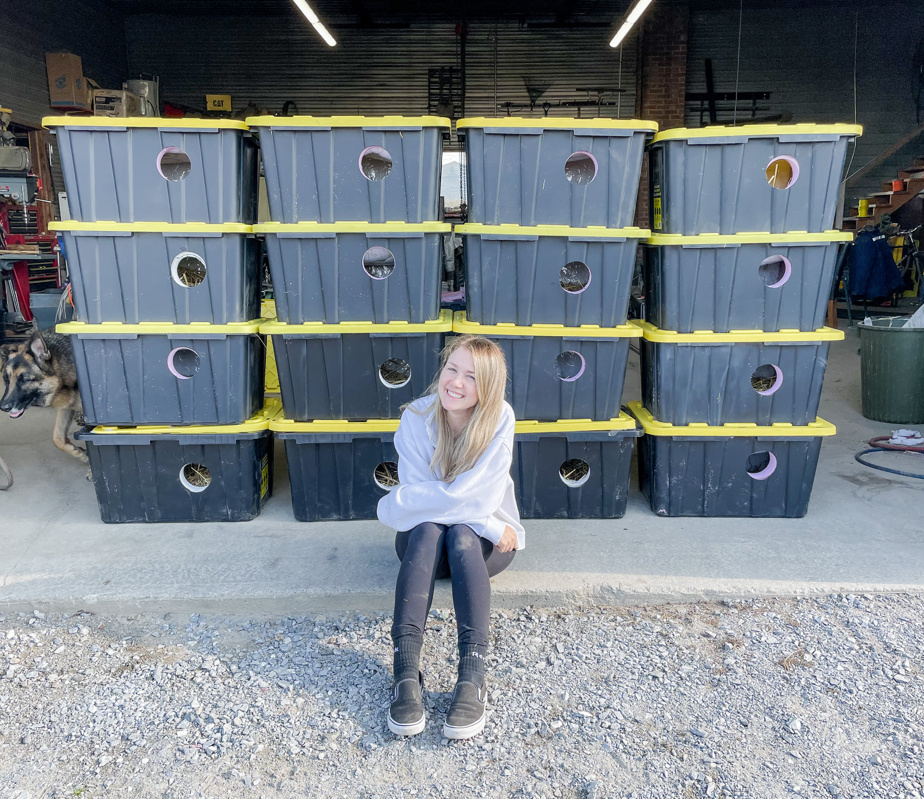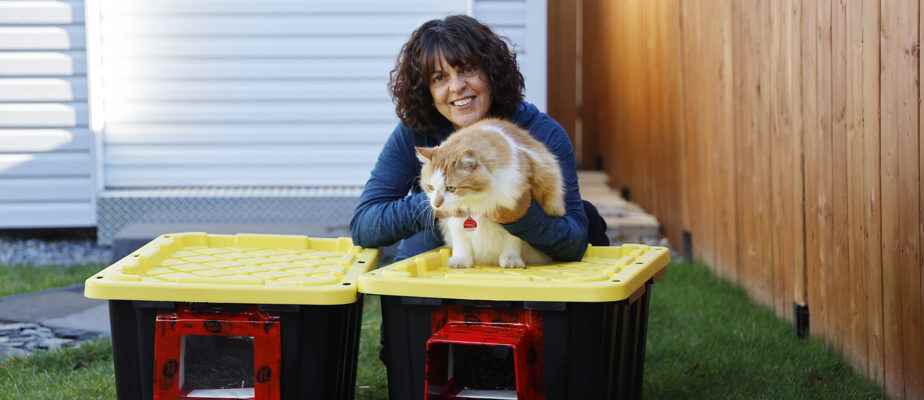Hundreds of mini-construction sites will soon give birth to as many small shelters for stray cats, scattered in courtyards, on balconies and in alleys this winter. Made by good Samaritans, these houses help to keep tomcats warm, but also to tackle the scourge of feline overpopulation.
By her own admission, Sophie Royer initially preferred dogs. But this resident of Saint-Hubert, saddened to see homeless kitties during the cold season, decided in 2016 to build a wooden shelter in front of her home. Quickly, one of its residents even had the honor of accessing the adjacent building: Hatchi, a former traveling cat, has since been adopted by the lady.
She continued to make roofs for chilly felines; each year, it manufactures and distributes several new models on a voluntary basis, claiming the cost of the materials used (container, styrofoam, straw, Plexiglas, etc.), ie around thirty dollars. “My goal is to encourage people to make them in turn, by explaining the method to them, so that they find it easy,” says Ms.me Royer.

PHOTO MARTIN CHAMBERLAND, THE PRESS
Sophia Royer makes a classic model, with a plastic tub, styrofoam and straw. His personal touches: a small awning in front of the entrance, and an exit door with a Plexiglas flap (useful for fearful cats who feel trapped with only one opening).
The installation of these shelters is not just an impulse from the heart, the purpose of the operation is also to lower the kitties to sterilize them, using CSRM programs (Capture, Sterilization, Release, Maintenance) offered by some shelters and municipalities. Chantal Séguin, a resident of the borough of Saint-Laurent, is a volunteer trapper in conjunction with the Montreal SPCA, to help stem the feline overpopulation in the city. “It’s a real plague in Quebec, these cats are really pitiful,” laments the one who built and distributed some 70 cat shelters this year, in addition to those installed in her neighborhood.
Large spans
A real community of builders of shelters for stray cats has also been structured, sharing their manufacturing advice, their materials and their achievements. It is notably federated around a Facebook page, “Chats au Chaud”, founded by Alexe Dupont in 2019.
The latter, after watching videos of shelter projects carried out in the United States, had sought to set up her own for her neighborhood. Launching a call to collect plastic bins on social media, his request quickly snowballed, with hundreds of people offering to help.

PHOTO FROM THE HOT CATS FACEBOOK PAGE
Alexe Dupont leads a community to encourage Quebecers to build winter shelters for stray cats.
“At first, I just wanted to build a shelter, but when I saw that people were boarding, I decided to create a page”, explains the one who gets back to it every fall by building around fifty shelters and motivates the others to imitate it, with instructions.
Since then, several hundred people are now helping out. Here too, the control of the feline population is part of the discussions. “Organizations like Proanima often give trapping advice, because the goal is also to have these cats sterilized and not to encourage colonies,” says Ms.me Dupont.
It’s in the box
Everyone has their recipe for making a stray cat shelter, but there is a basic model, with options. Carole Lacasse, director of customer service at Proanima, reveals the main points.
“You can take two Rubbermaid-type plastic bins, nesting one inside a larger one, and place styrofoam between the two. You can also do it in wood. In the bottom, you can put blankets that dry quickly or straw, but above all no hay, ”she says. Some use heat pads or lamps; However, caution is advised with these options to avoid any risk of fire.

PHOTO MARTIN CHAMBERLAND, THE PRESS
One of the cabins made by the resident of Saint-Hubert. It was placed sheltered from the wind, raised and stabilized with a plate on the roof.
Usually, the size of a shelter is planned for a single cat, in order to limit heat loss (in the model proposed by the organization, the nested boxes are respectively 40 liters and 68 liters). Ditto for the opening, ideally eccentric: the animal must be able to just pass the head there, that is to say about fifteen centimeters in diameter. The shelter must be raised above the ground, for example with pieces of wood, and ballasted with weight on the roof to stabilize it.
“We can’t just provide shelter, we also need to provide a source of water and food. It’s a whole, insists Mme Lacasse. Place them aside, sheltered from the weather. The water should be changed regularly, especially if it freezes. Kibbles do the trick, but they must be removed at night so as not to attract nocturnal animals. »
For these maintenance reasons, she recommends placing the installation in a place that is easily accessible in winter. It can be on a balcony, in a courtyard or an alley, sheltered from the wind. “Often, the cats will tell us if it’s placed in the right place and if they adopt the cabin or not”, concludes Mme Lacasse, who advises to check if a CSRM program is offered locally.
